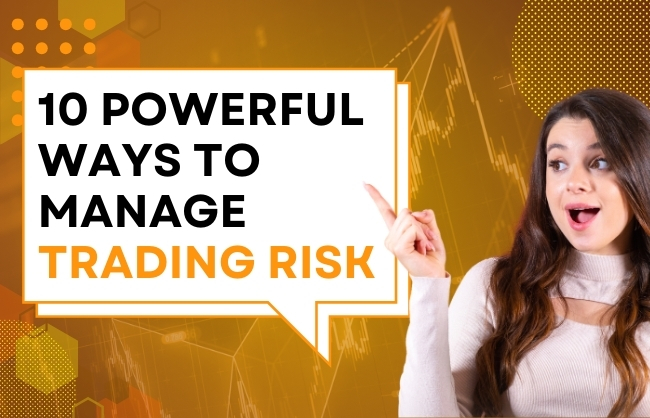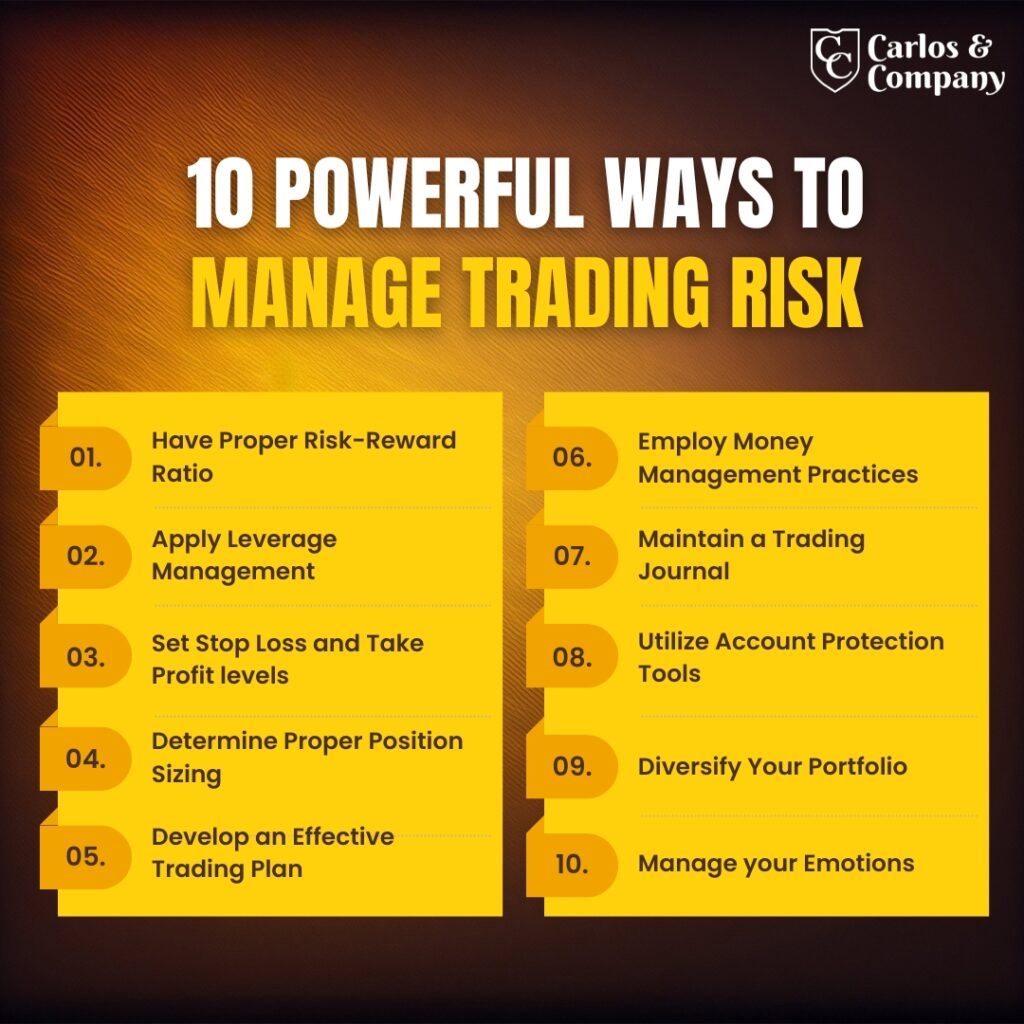10 Powerful Risk Management Tools In Financial Markets 2025
You may hear the popular phrase no gain without no pain. The same is applied in the financial market. You can make or lose money while trading in financial instruments.
According to the data, a significant amount of traders daily lose money in the market. That is because of not using proper risk management tools. In this article, we will have a detailed study regarding risk assessment & management.
Understanding the concept of Risk Management
The popularity of trading is increasing these days due to high returns. In reality, trading is a good option for side & active income by investing in valuable assets.
However, not always trading in gold, forex, cryptocurrencies, stocks, indices, metals, and energies is profitable. Similar to a business person, on some days you make a profit, and some lose; in trading also, wins & failure are part of the game.

Risk Management is a crucial process of determining, analyzing, and adjusting the risk to maximize the potential returns using different educational, analysis, and psychological tools.
The main aim of risk management is to stay consistently profitable and keep the overall profit more than the losses. While the method is used in almost every field & industry, its importance in financial trading is unmatchable.
Here's a quick look at what you'll read
Risk Management is a crucial process of determining, analyzing, and adjusting the risk to maximize the potential returns using different educational, analysis, and psychological tools.
Risk financing tools include insurance, self-insurance, hedging, reserves, and captive insurance to cover potential losses.
The main risk management tools are risk assessment, diversification, hedging, stop-loss orders, and insurance.
Mitigate risk by diversifying investments, using hedging strategies, setting stop-loss limits, and following proper risk management practices.
- Hedging (using options, futures, or derivatives)
- Diversification (spreading investments across assets)
- Stop-loss strategies (limiting losses on trades)
Top 10 Risk Management tools & techniques
Trading in the financial market, especially in the forex market, is affected by many fundamental, sentimental & technical analysis factors, including volatility, liquidity, correlations, economic reports, announcement & speeches, etc.
Risk analysis & management is a key to get success in financial trading. Here are some powerful tools that help you throughout your trading & enables you to maintain a consistent position even when the market conditions move against you.
Risk Reward Ratio: Always know the negative outcomes
Risk reward Ratio is a measurement of what you are risking to earn a particular amount. It is an assessment of the risk and profitability of a particular trade.
Suppose you are trading in EUR/USD. Your profit expectation is 100 USD, and chances of losing 25 USD. In this case, your risk-to-reward ratio is 4:1.
Always trade with a risk-reward ratio. The ideal risk-reward ratio for a trader is 3:1. Beginners should not take more risks than this ratio. Also, many platforms provide trade recommendations defining the risk per trade. So, place trade considering the amount of risk.
Leverage Management: Master the art of using leverage
Leverage is a crucial and important tools for trading. It enables the trader to place large amounts of trade with small capital. Basically, you can borrow money from your broker to open large positions.
However, excessive use of leverage may result in margin calls. Many brokers offer unrealistic high leverage. However, the risk is also high in such cases.
So it is essential to use it efficiently and a risk warning to avoid taking high leverage to eliminate significant losses. The amount of leverage against your capital is represented in ratios like 1:50, 1:500, 1:1000, 1:2000, etc.
Suppose you are trading with a 1:500 ratio; with this ratio, you can place a trade up to 500,000 USD with a capital of 1000 USD. However, novice traders should not take leverage more than 1:100.

Stop Loss & Take Profit: Trade order management Tools.
Stop Loss is a tool to limit your losses when the market moves against you, and take profit is used to safeguard the profit when the market favors you.
A trader should always place a trade setting these levels. Let us understand how these two technique work with an example.
Suppose you buy EUR/USD at 1.15000, set the stop loss at 1.13000, and take the profit at 1.1170.
In this case, if the price moves against you and reach 1.1000. Then as you have already set the stop loss level, your trade will automatically close at 1.13000 & you will not lose more money.
In the same example, suppose the price reached 1.1190 and then fell and came to 1.14000. It will not affect you, as the trade already closed when the price reaches 1.1170. For a detailed understanding, you can also go for risk management books available on our website.
Position Sizing: Determine your Risk per trade
Position Sizing is among the popular risk management tools to determine your risk per trade. To secure consistency, you should only risk a small part of your account balance.
Under this method, traders generally fix the risk percentage per trade. While placing each trade, they maintained the ratio. You can go for 1 to 3% of deposit risk per trade.
Always use an effective plan: Identify the 5 W & 1 H of trade.
One of the most common trading myths is you don’t need a strategy to place a trade. That is why many traders make huge losses. Forex or other financial markets are uncertain; trading without a plan may have severe effects.
Choosing a well-designed trading strategy is necessary based on your currency pair, trading session, method, capital, and other factors. Proper planning results in efficient implementation and desirable results.
An ideal trading plan contains important information, including what, why, when, where, who, and how to place a trade. From our risk management course available on the website, you can learn how to make a proper trading plan.
Money Management: Use your capital in the best manner
You are putting your hard-earned money in the market, so you must have a clear idea of how much your trading capital will be and the amount you will use per trade. It will help you decide your trade’s entry, exit, support, and resistance point.
It is advisable not to put more money than you can afford to lose. So you can maintain consistency even if the market moves against you or in the most unfavorable condition.
Trading Journal & Analysis: Learn from your past mistakes
A trader must keep a diary or record of all the trades with their opening, closing, stop loss, take profits, time, and other pivot details for dealing risk in Forex. This journal should be regularly analyzed and compared.
It will help you track the performance of your trading plans, indicators, and other resources used to place the trade. So, the next time you make a decision, you will try to avoid the mistake you made in the earlier trades.
Account Protection tools: Try to take maximum security measures
Account Protection is one of the most important risk management tools. Many forex brokers provide traders with stringent safety tools to protect the client’s interest.
These tools include guaranteed stop-loss orders, protection against negative balance, segregated accounts, leverage limits, etc. So, even a beginner or trader lacking market understanding does not lose all their money.
However, not all brokers provide such tools. So, select your broker after checking and comparing its account management tools to ensure the safety of your funds.
Portfolio Diversification: Multiple small trades instead of one Big trade
There is an old saying not to put all your eggs in the same basket, and in the financial market also, it is true. A trader should diversify the trading capital in different financial assets and markets.
Suppose you have put all your amount into one big trade, and the market moves against you, then the loss will be huge. In the same case, if you divide, you invest the amount in portions, then the loss from one will be adjusted by the profit from another trade.
Emotion management: Prepare for the worst
Trading is a game of profits and losses. Overconfidence during profits and hypertension during losses is very harmful. Your trading decision should be more logical and unaffected by instinct, greed, or fear.
A trader should use the right trading psychology to deal with positive and negative outcomes in the same and stable way. Discipline, Patience, and Consistency is the key to controlling your emotions and trading efficiently.
Final Words
Trading in Forex, cryptocurrencies, stock, or other financial markets is based on price predictions. The most experienced and advanced traders also suffer losses on some trades.
Even after using the best strategies, one may suffer a loss in financial trading. That’s why the knowledge of risk management tools and how to use them is a must for a trader.
If you are putting your money in the market without considering risk management, then it is no lesser than gambling. Trading is a popular way to make money and have a wealthy lifestyle. With the right approach and proper management, you can make billions in the forex market.
